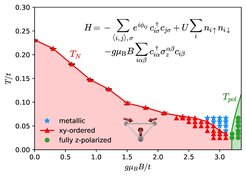Magnetism and metallicity in moiré transition metal dichalcogenides
Moiré transition metal dichalcogenides have attracted a lot of recent scientific attention due to their high tunability. An international team spearheaded by members of the Independent Research group SCQM (MPI-FKF) has investigated a theoretical model of these materials by means of cutting-edge numerical quantum embedding methods and found an intriguing metallic phase when a magnetic field is applied. The phase has also been observed in recent experiments.
Twisting two monolayers of transition metal dichalcogenides (for example WSe2) by a relative angle and putting them on top of each other results in the emergence of a triangular moiré lattice potential in which the electrons can move, leading to strong correlations between them. As a dramatic consequence, in these “artificial” materials, a multitude of fascinating physical phenomena like continuously tunable metal–insulator transitions, magnetism, and quantum criticality have been observed.

What makes these systems so appealing from an applicational point of view is their high tunability as well as the fact that, due to local minima and maxima in their electronic band structures (called “valleys”), they open up the possibility of precise quantum manipulation (“valleytronics”). From a theoretical perspective the ability to control the properties of twisted bilayer transition metal dichalcogenides in situ creates an ideal platform for investigating the interplay of strong correlations and geometric frustration due to the triangular moiré pattern.
In the paper recently published in the Proceedings of the National Academy of Sciences of the United States of America (PNAS), the moiré Hubbard model, believed to capture the essential physics of such devices, has been analyzed by means of cutting-edge numerical methods. The work was spearheaded by Patrick Tscheppe, Master student within the independent Max Planck Research Group for the Theory of Strongly Correlated Quantum Matter (SCQM), and led by the head of SCQM, Thomas Schäfer. In an international collaborative effort (including scientist from the Center for Computational Quantum Physics at the Flatiron Institute, Columbia University, Oak Ridge National Laboratory, and Collège de France) the model’s phase diagram has been established as a function of temperature and applied magnetic fields. Apart from insulating magnetic phases an intriguing intermediate metallic regime has been found at finite temperatures, also observed in experiments. These findings represent an essential step toward the understanding of recent experiments and the model’s applicability.











